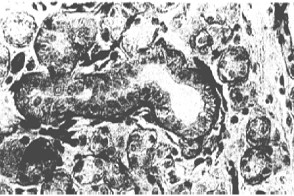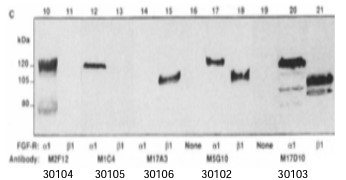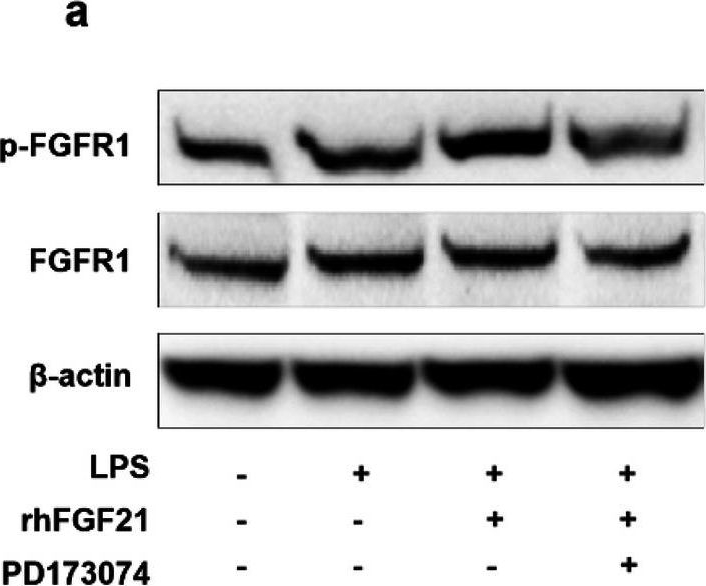Anti-Fibroblast Growth Factor Receptor 1 (FGFR1) Antibody (Clone M5G10)
Anti-Fibroblast Growth Factor Receptor 1 (FGFR1) Antibody (Clone M5G10)
Product No.: 30102
- -
- -
Clone M5G10 Target Fibroblast Growth Factor Receptor 1 (FGFR1) Formats AvailableView All Product Type Monoclonal Alternate Names FGFR-1, EC 2.7.10.1, Basic fibroblast growth factor receptor 1, BFGFR, bFGF-R-1, Fms-like tyrosine kinase 2, FLT-2, N-sam, Proto-oncogene c-Fgr, CD antigen CD331 Isotype Mouse IgG1 Applications IHC , IP , WB |
Data
 Immunohistochemistry:
Immunohistochemistry:10ug/ml, paraffin- embedded tissue. Detection of FGFR-1 in normal salivary gland.
- -
- -
Antibody DetailsProduct DetailsReactive Species Human Host Species Mouse Immunogen Recombinant human ectodomain of FGFR-1b expressed in E. coli beginning with proline 23; antigen contained NH2-terminal gly-ser-pro-gly-ile and COOH-terminal glu-phe sequences. Product Concentration Lot Specific Formulation This monoclonal antibody is aseptically packaged and formulated in 0.01 M phosphate buffered saline (150 mM NaCl) PBS pH 7.2 - 7.4 with no carrier protein, potassium, calcium or preservatives added. State of Matter Liquid Product Preparation Purified by Protein G affinity chromatography Storage and Handling These antibodies are stable for at least one (1) year at -20°C to -70°C. Store product in appropriate aliquots to avoid multiple freeze-thaw cycles. Country of Origin USA Shipping Next Day 2-8°C Applications and Recommended Usage? Quality Tested by Leinco Immunohistochemistry: 10ug/ml, paraffin- embedded tissue. Immunoblotting: 1ug/ml recognizes 10ng recombinant bacterial, baculoviral or native FGFR1. Immunoprecipitation: native, recombinant, and ligand-labeled FGFr1. Each investigator should determine their own optimal working dilution for specific applications. See directions on lot specific datasheets, as information may periodically change. DescriptionDescriptionSpecificity Clone M5G10 monoclonal antibody is specific to both α (denatured) and β isoforms of FGF Receptor 1 (FGFR1). Epitope is within the sequence his241 and val267 between Ig loops II and III. Epitope is masked in undenatured FGFr1α. Background The fibroblast growth factor (FGF) family is a group of multi-functional polypeptides that function in embryonic development, tissue repair, neuronal cell survival, cardiovascular disease, and tumorigenesis. The biological activities of FGF are mediated by cell surface receptors that have tyrosine kinase activity. FGFR-1 is activated by FGF-1 and FGF-2. In neoplastic cells, overexpression of FGF-1, FGF-2 and FGF receptors appear to contribute to cellular trans- formation and proliferation. Why Choose Our Anti-FGFR1 (Clone M5G10) Antibody? Central Mediator of FGF Signaling: FGFR1 is a crucial receptor tyrosine kinase that orchestrates the diverse biological activities of the Fibroblast Growth Factor (FGF) family. These multifunctional polypeptides are vital regulators in processes ranging from early embryonic development and tissue repair to neuronal cell survival. Our M5G10 clone provides a precise probe for detecting and analyzing this pivotal receptor. Activated by Key Ligands: FGFR1 is specifically activated by its high-affinity ligands, FGF-1 and FGF-2. Understanding these interactions is fundamental to deciphering downstream signaling pathways and cellular responses. This antibody enables robust detection of FGFR1, allowing researchers to study its activation and role in various cellular contexts. Critical in Cancer Research: Dysregulation of FGFR1 signaling is frequently implicated in tumorigenesis and cancer progression. Overexpression of FGF-1, FGF-2, and various FGFR family members, including FGFR1, is known to contribute significantly to cellular transformation and uncontrolled cell proliferation in neoplastic cells. Versatile Applications for Comprehensive Analysis: Clone M5G10 is rigorously validated for use in a wide array of experimental techniques, providing researchers with flexible options for their studies Function Tyrosine-protein kinase that acts as cell-surface receptor for fibroblast growth factors and plays an essential role in the regulation of embryonic development, cell proliferation, differentiation and migration. Required for normal mesoderm patterning and correct axial organization during embryonic development, normal skeletogenesis and normal development of the gonadotropin-releasing hormone (GnRH) neuronal system. Phosphorylates PLCG1, FRS2, GAB1 and SHB. Ligand binding leads to the activation of several signaling cascades. Activation of PLCG1 leads to the production of the cellular signaling molecules diacylglycerol and inositol 1,4,5-trisphosphate. Phosphorylation of FRS2 triggers recruitment of GRB2, GAB1, PIK3R1 and SOS1, and mediates activation of RAS, MAPK1/ERK2, MAPK3/ERK1 and the MAP kinase signaling pathway, as well as of the AKT1 signaling pathway. Promotes phosphorylation of SHC1, STAT1 and PTPN11/SHP2. In the nucleus, enhances RPS6KA1 and CREB1 activity and contributes to the regulation of transcription. FGFR1 signaling is down-regulated by IL17RD/SEF, and by FGFR1 ubiquitination, internalization and degradation. {UniProtKB:P16092, PubMed:10830168, PubMed:11353842, PubMed:12181353, PubMed:1379697, PubMed:1379698, PubMed:15117958, PubMed:16597617, PubMed:17311277, PubMed:17623664, PubMed:18480409, PubMed:19224897, PubMed:19261810, PubMed:19665973, PubMed:20133753, PubMed:20139426, PubMed:21765395, PubMed:8622701, PubMed:8663044}. NCBI Gene Bank ID UniProt.org Research Area Growth Factors, Cytokines, Receptors References & CitationsXu et al. (1992) J Biol Chem 267: 17792 Wang et al. (1995) J Biol Chem 270: 10231 Myoken et al. (1996) J Pathol 178: 429 Kong, S., Cao, Y. (2020), et al. Cell Mol Med. 24(8):4677-4686 FGF21 alleviates neuroinflammation following ischemic stroke by modulating the temporal and spatial dynamics of microglia/macrophages. J Neuroinflammation (2020) [32867781] Technical ProtocolsCertificate of Analysis |
Formats Available
- -
- -
Prod No. | Description |
|---|---|
30102 |




